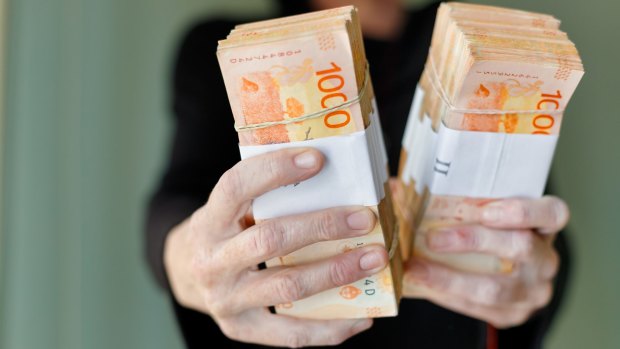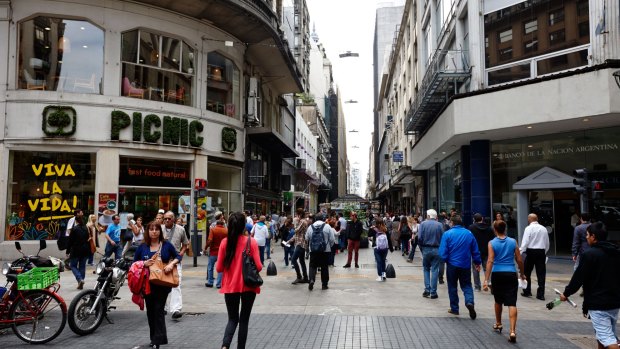This was published 1 year ago
Argentina's 'blue dollar' currency exchange: The weird system that lets tourists double their money
By Michael Fowler

Exchanging about $200 to Argentine pesos will get you a grotesquely sized wad of cash.Credit: iStock
As you wind through the bohemian San Telmo district, past the wooden facades and chalkboards of Buenos Aires' corner shop cafes, the whiff of browning pastry catches your nose.
The hole-in-the-wall empanada dealer removes your pillowy satchel of goodness from an Italian brick pizza oven, lays it on a napkin and requests 250 Argentinian pesos.
Cash or card, they ask. In other words: would you like to pay $1 or $2?

Buenos Aires's busy Calle Florida. Credit: Alamy
To understand how this scenario exists, our tour of Argentina's capital continues north. If you listen beyond the grind and whizz of espresso machines, you can hear the city's old guard turning the pages of newspapers in cafes.
Until you arrive at Calle Florida.
"Cambio! Dolares! Euros!" bellow the tracksuited men and women, dotted every 20 metres along the city's central pedestrian thoroughfare.
Sometimes it's a more personal address: "Cambio, amigo? (Exchange, my friend?)"
Street money exchange? Most people know to normally avoid it like you avoid a stranger offering to help you use an ATM.
Yet in Argentina these operators – known as "arbolitos" ("little trees"), owing to the colour of their preferred US currency and stationary positions – are not only reliable, they are your window to the country's semi-official "blue dollar" exchange rate, where acquiring cash locally doubles your money compared to the official rate. Yes, you read that right. Keep reading.
Argentina's inflation rate has spiked dramatically at several points over the last decade, contributing to the lowering value of the peso. When Argentina's currency slides, demand for US dollars – viewed as a stable foreign currency – increases.
That has never been truer than now. Inflation grew nearly 95 per cent in 2022, the highest annual rise since 1991.
According to the official exchange rate, one Australian dollar gets you 130 pesos. The blue dollar rate is 265 at time of writing.
Aside from arbolitos, who also line the streets of major cities such as Cordoba and Mendoza, Western Union allows foreigners to access the blue dollar. Using only your mobile phone, you can set up an account, transfer money to your own name and collect it within minutes.
While Western Union generally offers a slightly lower rate than arbolitos, it removes the need to enter the country stocked with US dollars or euros.
All this is to say: it's wonderfully easy to access Argentina's cash economy and all its cut-price pleasures.
We're talking $A15 for a sumptuous steak, side and glass of wine. About $A4 for a cocktail at a bar. A singular dollar for your favourite empanada (carne picante, "spicy meat", for me).
Perhaps you could tuck into one as you hike among snow-capped mountains or realise your insignificance in the face of enormous glaciers near the Patagonian towns of El Chalten and El Calafate.
Bariloche is Argentina's skiing capital in winter. In summer, that translates to bathing in transparent lakes as the winter's melting snow watches on from the mountaintops. Or you could sip malbec in Mendoza, navigate the desert in northern Salta, or party in Mar del Plata – Argentina's Gold Coast.
Oh, and I've never seen so many bidets in bathrooms.
Beyond the opulence, Argentina's blue dollar will lead you through scenarios that feel half crime movie, half TV game show.
After haggling with my first arbolito in Buenos Aires, he directed me up a staircase and into a brightly lit, white tiled room that resembled something between late night service station and laboratory. Over went my $US180 to the man sitting behind a counter. In return came the most grotesquely sized wad of cash, about 100 of both Argentina's green 500 peso and purple 100 peso notes.
Spare a thought, then, for the bus station vendors whose bosses are cruel enough not to provide them a note counter. When buying a 24-hour bus ticket worth $150 in Patagonia – one unexpectedly hefty expense – it took the man five minutes to count out my pesos.
"Así es en Argentina," he chuckled in good humour. ("That's how it is in Argentina.")
Workarounds exist even for purchases where it appears paying online with a card is unavoidable, such as flights. Aerolineas Argentinas and budget airline FlyBondi offer the option to deposit cash at desks in newsagents.
Of course, a surging blue dollar rate represents more difficulties for many Argentinian workers, who feel as if they are losing money despite receiving their salaries.
One American expat told me he was paying $A300 per month for a top-floor, one-bedroom apartment in Buenos Aires' trendy Palermo district. He easily acquired the place simply because it is beyond the capabilities of most locals.
Nonetheless, arguably South America's most diverse country is enthusiastically welcoming tourists who can inject money into the economy. A man named Messi has also helped them enter 2023 in a particularly joyous mood.
The writer travelled at his own expense.
Sign up for the Traveller Deals newsletter
Get exclusive travel deals delivered straight to your inbox. Sign up now.